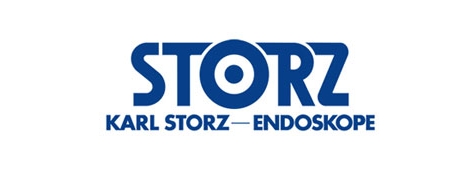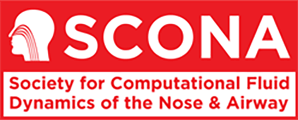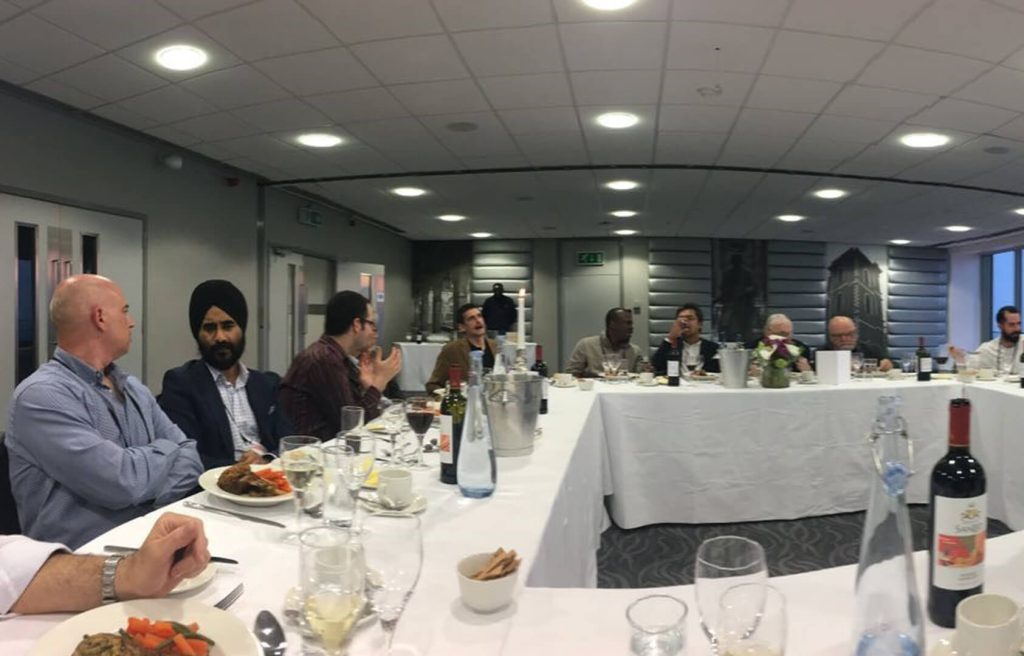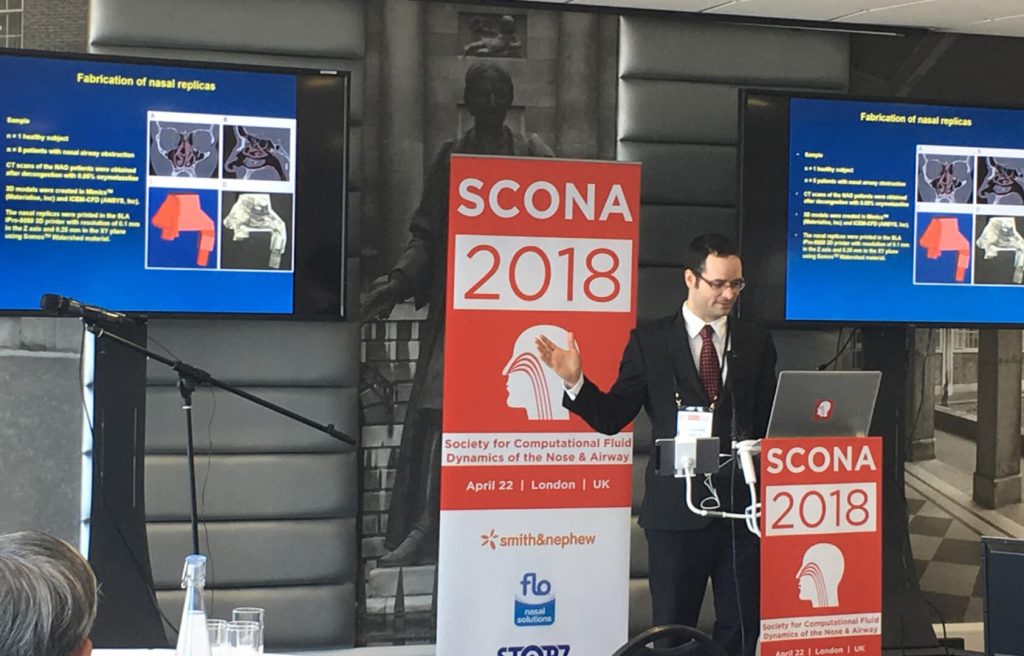SCONA 2018
The inaugural World Congress of the Society for Computational Fluid Dynamics (CFD) of the Nose and Airway (SCONA) was held on 22 April as a pre-event meeting, in conjunction with ERS London. International experts in rhinology and engineering from over 20 countries met for a one-day programme featuring 35 presentations.
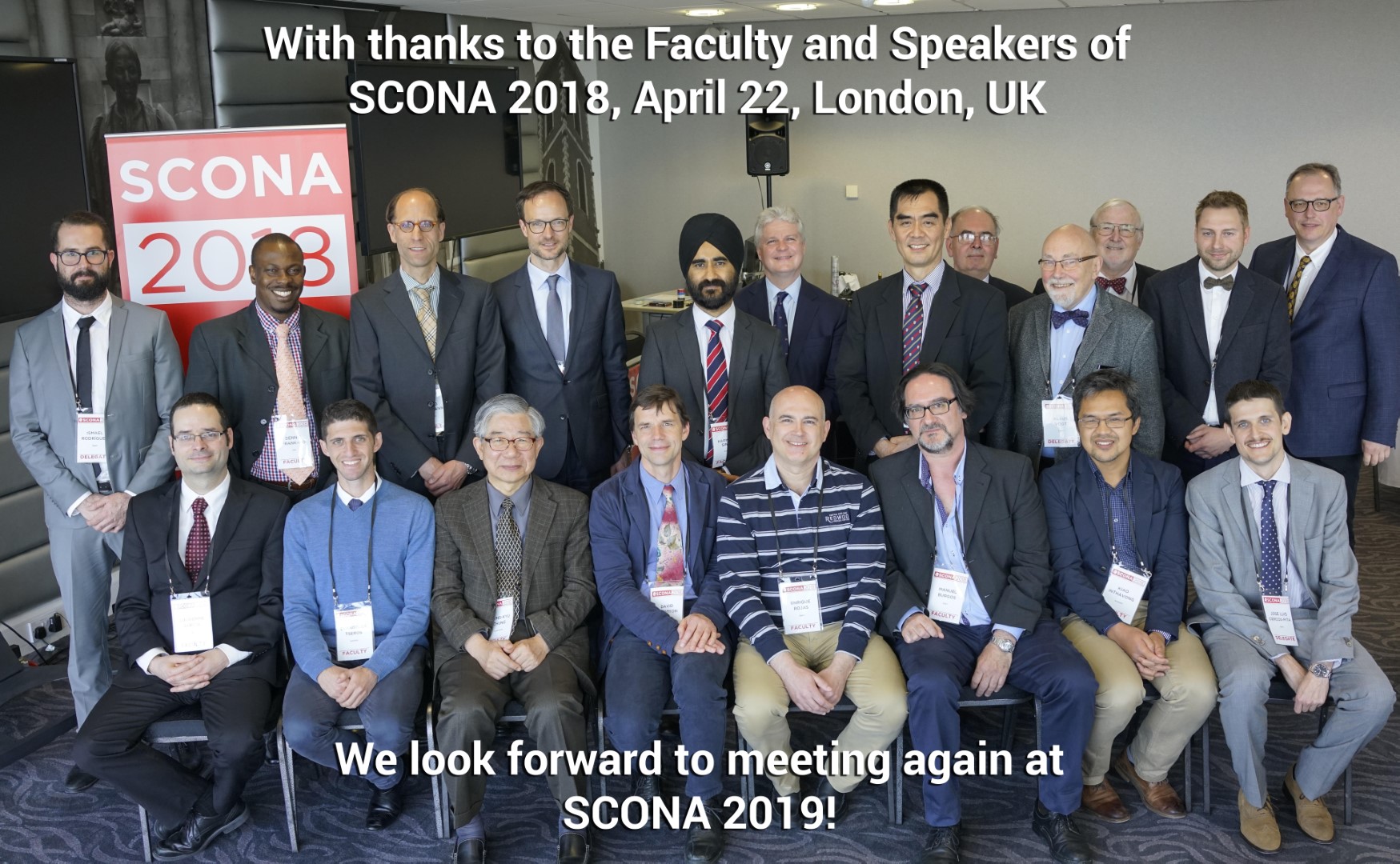
Faculty and Speakers (left to right, top to bottom): Dr. Ismael Rodriguez, Prof. Dennis Frank-Ito, Prof. Joerg Lindemann, Dr. Fabian Sommer, Dr. Narinder Singh, Prof. Neil Tolley, Prof. De Yun Wang, Dr. Graham O’Neill, Prof. Klaus Vogt, Prof. Walter Koch, Dr. Andreas Lintermann, Dr. Jochen Schachenreiter, Prof. Guilherme Garcia, Dr. Evangelos Tseros, Prof. S K Chung, Prof. David Wootton, Prof. Enrique Sanmiguel Rojas, Prof. Manuel Burgos, Dr. Kiao Inthavong, Dr. Jose Luis Cercos-Pita
ABSENT: Prof. Denis Doorly, Dr. Raul Cetto, Dr. Catherine Rennie, Prof. Masaaki Suzuki, Dr. Hadrien Calmet, Dr. Charlotte McIntyre, Dr. Eugene WongKiao Inthavong: Modelling air conditioning function during inhalation
Video Presentations
SCONA 2018, April 22, London, UK. Session 1: Engineering Fundamentals
SCONA 2018, April 22, London, UK. Session 2: Sim. & Clin. Implications
SCONA 2018, April 22, London, UK. Session 3: Clinical
SCONA 2018, April 22, London, UK. Session 4: Frontiers and New Research
PROGRAM (see videos above)
1 Engineering Fundamentals
1.1 Welcome
1.2 Introduction and historical overview
1.3 Acquisition of imaging data
1.4 Constructing the model
1.5 Physiological considerations – flow, surface, deformity, temperature, mucosal interface, nasal cycle
1.6 Models of flow (turbulence, steadiness, compressibility)
1.7 Interpreting simulation results
1.8 Software considerations – current and future
2 Simulation and Clinical Implications
2.1 Controversies, challenges and future directions in simulation
2.2 Correlating CFD with objective clinical testing and physical models
2.3 CFD results for airflow in the normal nose
2.4 CFD results for airflow in the normal airway
2.5 Temperature, humidity and olfaction
2.6 Ethnic variation
3 Clinical
3.1 Drug delivery and particle deposition
3.2 Septal deviation
3.3 Septal perforation
3.4 Inferior turbinate surgery and The Empty Nose Syndrome/ Atrophic rhinitis
3.5 The nasal valve
3.6 Virtual surgery – modifying the model
3.7 Sinus surgery
3.8 The upper airway – pathology and surgery
3.9 CFD modelling: under CPAP and during nasal and oral breathing
4 Frontiers and New Research
4.1 Physical Parameters determining Clinical Indications for CFD Simulations: The New Agreement of the International RIGA Consensus Conference on Nasal Airway Function Tests
4.2 Predicting Patient-Reported Improvement Scores After Nasal Airway Obstruction Surgery Using Computational Fluid Dynamics Modeling Airflow and particle deposition in large airway under sniff condition
4.3 Airflow and particle deposition in large airway under sniff condition
4.4 The role of CFD in the pathogenesis of chronic rhinosinusitis
4.5 Ventilation of the Anterior Ethmoid, the Maxillary and Frontal Sinus with Special Consideration of the Ethmoid Infundibulum with Computational Fluid Dynamics (CFD)
4.6 Nasal-Geom, a free software for the nasal cavity reconstruction
4.7 Nasal-flow: an automatised web service for the airflow analysis of the human upper airways
4.8 Segmentation of the Nasal Cavities and Paranasal Sinuses Using Artificial Intelligence
4.9 Analyses of nasal cavity flows based on highly-resolved CFD computations
4.10 Dimensionless Parameters to distinguish health from disease
4.11 Custom CFD software for Rhinologists (MeComLand, NoseLand)
4.12 A prospective CFD study assessing Retrosternal Goitres
4.13 Study of Sensitivity and Specificity of Fully Automated CFD Solution in Patients Affected by Nasal Airway Obstruction (NAO)
CFD is revolutionising surgery of the nose and sinuses by providing validated, reliable and precise scientific measurements, including airflow streamlines, velocity and pressure, temperature and wall shear stress.
In the past, highly sophisticated computer modelling of airflow was only available to government and corporate aerodynamic engineering labs, such as Formula 1 race teams and multinational aircraft manufacturers. Recent advances have put this game-changing technology into the hands of ENT surgeons, clinicians and researchers.
Surgeons can now perform “virtual surgery” to model the flow of air through the nose and airway of actual patients, with unprecedented accuracy and precision.
The conference began by showcasing the engineering fundamentals used to create computer simulation of nasal airflow. This was followed by the clinical of use of CFD in studies of nasal airflow, septal deviation, inferior turbinate surgery, septal perforation, sinusitis, the nasal valve, the trachea, OSA and CPAP and nasal drug delivery.
Highlights of the meeting included breathtaking video animations created at the Barcelona Supercomputing Centre, the outstanding work on nasal and tracheal airflow by the team at Imperial College, London (led by Professors Denis Doorly and Neil Tolley), new insights into temperature regulation and septal perforation from Ulm, Germany (Professor Jeorg Lindemann and Dr Fabian Sommer), fascinating studies of nasal drug delivery and particle deposition (Dr Kiao Inthavong, RMIT, Australia), unique methods of correlating CFD results with patient symptoms (Professors Dennis Frank-Ito and Guilherme Garcia, USA), novel experiments revealing airflow within the sinuses (Dr Jochen Schachenreiter, Austria and Professor SK Chung, Korea), and Customised CFD software designed specifically for ENT surgeons from multiple academic centres in Spain.
Click here for SCONA 2019 or visit www.scona.org/scona2019
SCONA 2018 was CPD Approved by ENT UK for 8 Credits

The Organising Committee wishes to thank the following Industry Partners for their generous support of SCONA 2018:
